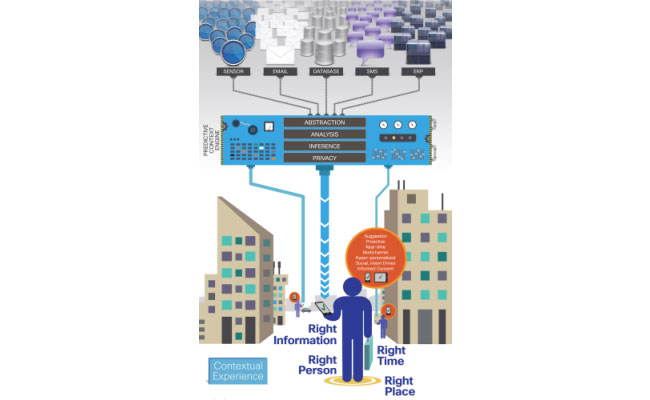Predictive Context: At Your Service – The Right Data at the Right Time
Imagine your next visit to the hardware store. The moment you walk in the door and the store’s network identifies your smartphone, it knows you were looking up tile repair earlier in the day.
As you walk the aisles, a video remote assistant pops up on your smartphone offering to help you find the tools you need and walk you through the repair process. The network is so smart it also knows about your previous purchases, and helps you with another project on your to-do list. Finally, it gives you a coupon on the spot to close the deal.
Addressing data overload:
Today, we can access data anywhere, at any time, from any device. But the amount of data available is so huge that it has become overwhelming—and not always particularly useful. Predictive context-aware computing, illustrated in our example, addresses this problem. It is also the next evolution of the Internet—the Internet of Everything (IoE).
Predictive context goes beyond anytime, anywhere data. Networks can anticipate what you need and then provide it. This completely transforms the user experience. In this new world, users receive the right data, at the right place, at the right time, and on the right device. Automatically.
The opportunities are almost endless:
In the consumer world, we already find instances where information—a nearby restaurant or a product suggestion—is “pushed” to a user.
In the business world, our imagination is the only limit. Increased productivity. More loyal customers. And the financial opportunity is huge. In fact, US$140 billion in new value creation.
From a technology perspective, we need four building blocks to build a predictive context platform on top of a network:
- The abstraction layer: Aggregates sources of context
- Near real-time data analysis: Detects relevant information
- The inference engine: Determines the appropriate action
- The privacy layer: Retains user control of the information they choose to share
Location is a key factor in predictive context-aware computing. Businesses can monitor Wi-Fi connected devices and analyze location information in real time. Like our hardware store, they can then offer additional value to their customers.
Predictive context-aware computing can just as easily apply to airline services, connecting ground handlers, real-time flight data, and weather information, to redirect airplanes. Airlines could save billions in fuel costs and flight delays.
The sky is the limit.
Location and activities analytics fuel predictive context-aware services:
Predictive context-aware services are still in the early stages of development, but are gathering momentum very quickly. Real-time analytics innovations, a key technical building block, are fueling these services. Location analytics are a particularly critical component. And we are seeing more focused research on location awareness and activity recognition.
User activity and location are the main sources for context. So it makes sense that most innovations today target transportation and consumer goods, including retail. Energy and utility companies are also prime candidates for predictive context-aware computing. By relying on environmental sensor data, for example, energy utilities can better predict peak demand and organize their supply accordingly. This could help lower energy utility rates. One invention in this area is the smart thermostat.
In the future, we can expect to see context-aware services available across a wide range of industries.
(This Content is an Advertorial)










